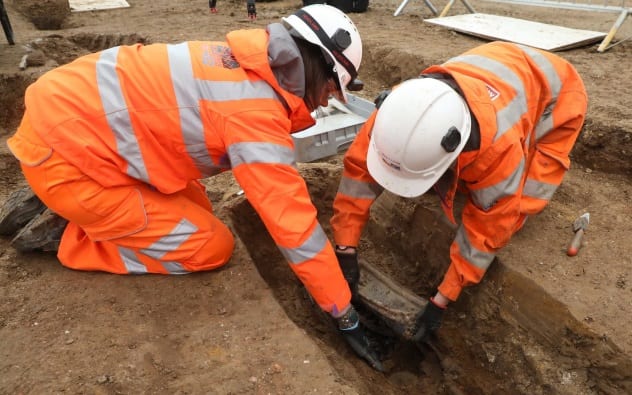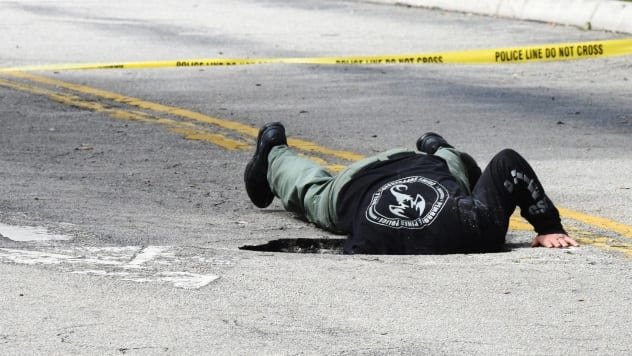We cover a few enigmas this week. There is something really strange happening in a tiny Canadian town, while Spanish authorities are trying to determine the mystery owner of a plane sitting in the Madrid airport. A third conundrum is put to rest as archaeologists rediscover the burial ground of an English explorer lost 150 years ago. In science news, researchers planned one of the most ambitious experiments in history, developed a laser that whispers in your ear, and saw if Spock is wiser than Yoda.
10 Fortunate Folk Find Flinders, Finally
Archaeologists excavating for England’s new High Speed 2 (HS2) railway uncovered the final resting place of Captain Matthew Flinders, an explorer whose burial location was lost to history roughly 150 years ago. At the start of the 19th century, Flinders led the first European circumnavigation of Australia. In total, he made three trips to the continent and recorded his adventures in a popular book called A Voyage to Terra Australis. He died in 1814 and was buried at St James’s Church in the center of London. Over the following decades, the cemetery saw extensive alterations and was finally turned into St James’s Gardens in 1878. Later, parts of the gardens were built over for the Euston railway station. By then, people had long forgotten where Flinders was buried, although there was always a myth that the captain was interred below platform 15. That didn’t turn out to be the case, though, as his remains were found while digging for a new high-speed railway. Fortunately, Flinders was buried with a lead breastplate which had not corroded and still had his named engraved on it.[10] The remains will, most likely, be reburied at a new location yet to be determined. This spot was just one of 60 archaeological sites along the route of the future HS2 which will be explored before construction can begin.
9 The Ghost Plane Of Madrid
Officials from the Madrid-Barajas Airport in Spain are trying to find out who parked and abandoned a jetliner on their tarmac. The Madrid airport might be among the largest in Europe, but even for a place of this size, it is unusual to leave an airplane untouched for years. And the aircraft is a McDonnell Douglas MD-87, a jetliner that seats over 100 passengers, so it isn’t exactly tiny.[2] And yet it has been parked in the same place so long that airport authorities don’t know who owns it anymore. Airport director Elena Mayoral placed a notice in the official Spanish bulletin regarding the abandoned plane. In accordance with Spanish law, officials must publish these notices for three straight months and then wait a year for the owner to come forward before being able to auction off the plane. So it looks like the aircraft will stay right where it is for the foreseeable future.
8 Vanilla Inebriation
A woman from Connecticut was arrested for driving under the influence of vanilla extract. If there is one thing to learn from history, it’s that humans have always enjoyed getting wasted. No matter how unusual or unpleasant a substance might be, if it gets you blotto, then there will be someone somewhere willing to try it. Our latest example is Stefanie Warner-Grise, a 50-year-old woman from New Canaan, Connecticut. Officers investigated a report that she had stopped her car in an intersection and was sitting in the driver’s seat with her eyes closed. A quick chat revealed that she was clearly inebriated, and after a failed sobriety test, she was taken into custody. As it turned out, Warner-Grise had gotten drunk off vanilla extract.[3] Officers found several bottles in her car and could smell the scent of vanilla on her breath. Vanilla extract is surprisingly potent. Per US Food and Drug Administration (FDA) regulations, the solution must be 35-percent alcohol by volume, at least. The alcohol typically evaporates during cooking, but if you drink it straight up, it is slightly less intoxicating than whiskey.
7 The Whisper Laser
Researchers from MIT have created lasers that can whisper sounds directly into a person’s ear. The system works based on a phenomenon called the photoacoustic effect, which causes sound waves to form when a material absorbs light. In this case, the material is the water vapor naturally found in air. A 1.9-micrometer thulium laser is pointed at someone’s ear, excites the moisture surrounding it, and is able to quietly transmit a message to that person. The MIT team experimented with different wavelengths and found the ones which are best absorbed by water. They also developed two techniques of transmitting the signal. One is through traditional modulation, while the other one sweeps the beam back and forth by bouncing it off a mirror. The former method provides higher audio fidelity, while the latter creates a louder message.[4] The scientists behind the technology claim the laser is perfectly safe and believe it will have numerous commercial applications in the future. At the moment, the “whisper” beams work at a distance of 2.5 meters (8 ft), so the next goal will be to move up to longer distances.
6 Yoda vs. Spock
Star Wars vs. Star Trek is a decades-old rivalry. Fans of the two iconic sci-fi franchises are always butting heads, but Canadian researchers from the University of Waterloo have stepped in to settle one debate: Who is wiser? Spock or Yoda? The tiny ancient Jedi and the Vulcan second-in-command are generally considered to be the smartest characters in their respective franchises and have become archetypes of sage wisdom, but is there a way to determine if one is superior to the other? There is one trait which distinguishes the two—emotion. Spock dismisses anything he considers illogical and refrains from showing almost any emotion, while Yoda teaches his pupils to embrace their feelings and does so himself. Researchers ascertain that a rich emotional life would be beneficial to wisdom, which is why the Jedi master is the wiser of the two. Psychologist Igor Grossman and his team ran various experiments over four years involving almost 3,700 participants to see how emotional states impacted the reasoning process. They concluded that experiencing a diverse and balanced range of emotions leads to wise reasoning—a state defined by intellectual humility, recognition of different perspectives, and willingness to integrate and compromise.[5]
5 Enter The Hellevator
A group of Welsh shoppers experienced an ordeal out of a horror movie as they were trapped for 40 minutes in an elevator which repeatedly climbed to the top and then plunged back down again. Last Saturday, over a dozen people became stuck in a lift at the St David’s Shopping Center in Cardiff. Being trapped in an elevator is nerve-wracking on its own, but this machine kept going to the top of the mall and then forcefully going back down as it jolted all of its occupants. It did this for 40 minutes before a fire brigade was able to get everyone out.[6] To make matters worse, the helpline was not working for the first ten minutes, so the people stuck inside had no idea what was going on. Physically, everybody was fine, although they did all receive the fright of their life, and one young girl suffered a panic attack. A spokeswoman for the shopping center didn’t give any reason for the malfunction, simply stating that there were no previous reports of faults with the elevator. For their ordeal, the shoppers were given free parking passes.
4 The 500-Year Experiment
Scientists from the University of Edinburgh have published the initial results from an experiment which is designed to run for the next 495 years. Back in 2014, a group of researchers from Scotland, Germany, and the United States banded together to study the longevity of bacteria. Charles Cockell, one of the collaborators, once forgot about a petri dish with Chroococcidiopsis, only to find that the cells were still viable ten years later. Other scientists were able to revive bacteria much older than that. So how long do bacteria last for, anyway? And is there a predictable way to calculate the rate of loss of viability? These are the questions that the research team wants to answer, but even if the experiment succeeds, none of them will be around to enjoy it. That is because the test is scheduled to end in 2514.[7] They have only just published the initial results following the first two years of waiting. The experiment consists of 800 glass vials hermetically sealed and filled with Chroococcidiopsis or Bacillus subtilis. Half of them are shielded from radiation using lead. Performing the evaluation is easy. All the tester has to do is take a few vials periodically, open them, add water, and check the number of bacteria colonies. The tricky part is finding people to keep the experiment running hundreds of years from now.
3 Burglars Burrow Beneath Bank
Police officers from Florida investigated a sinkhole and discovered that it was actually an unfinished tunnel leading underneath a bank. Wednesday morning, Pembroke Pines PD got a call about a possible sinkhole near a shopping center. Upon closer inspection, officers realized that the hole was a narrow tunnel that someone had dug from a nearby wooded area to reach the Chase Bank inside the plaza. In the tunnel, police recovered a small generator and a power cord. They also found a winch, a ladder, a stool, a pair of muddy boots, and a small wagon outside the entrance, which was covered with a wooden pallet. FBI special agent Michael D. Leverock described the situation as “truly a unique case.” He said the tunnel was “very claustrophobic” and was 45 meters (150 ft) long and around 90 centimeters (3 ft) in diameter.[8] Scent dogs have determined that there aren’t any bodies inside the tunnel. Authorities aren’t sure yet if the tunnel was abandoned or if the recent rainfall caused it to collapse. They have posted photos of the wagon and the generator, hoping that someone might be able to identify the would-be bank robbers.
2 The Carstairs Conundrum
Something strange is happening in a small town in Alberta, Canada, and nobody is able to figure out why. Cars are acting bizarrely when they are parked outside the Westview Co-op grocery store in Carstairs. The most common issue seems to be key fobs that stop working, but there have also been alarms that go off for no reason and cars that simply won’t start.[9] The problems seem to have been going on for weeks and are concentrated in the parking lot of the co-op. The store managers have called in electricians, but they have not been able to solve the mystery. At the very least, they shut down the power source from the co-op to confirm that it isn’t the cause of the interference. The RCMP confirmed that they have received multiple reports regarding the parking lot and, ultimately, plan to look into it, but they admit that it is not a high priority. With no official answer, people have begun to speculate regarding the cause of the interference. They think it could be anything from LED bulbs or a radio antenna to train tracks and nearby security systems. And, of course, aliens. Update: The mystery has since been solved. A remote car starter in the vicinity was stuck in transmit mode, causing the interference. Neither the co-op nor aliens were to blame.
1 Burger And Coke
A new fast food restaurant in Melbourne, Australia, called Pablo’s Escoburgers has garnered a lot of attention recently because it is themed around infamous Colombian drug lord Pablo Escobar. The centerpiece of the controversy seems to be the restaurant’s signature “Patron Burger,” which is served with a line of white powder and a rolled-up American $100 bill.[10] Of course, the money is fake, and the powder is actually white garlic, but people still found it in poor taste. Critics are saying that the restaurant is profiting off the misery of the drug trade by glorifying one of the world’s most ruthless criminals and making light of drug use. The backlash to the burger joint prompted one of the co-owners to release a statement saying that they have no intention to offend and are simply “taking the piss” out of Escobar while enjoying a good play on words. At the moment, the restaurant has no plans to change the name or the menu.
























